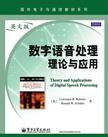数字语音处理理论与应用
2011-1
电子工业出版社
Lawrence R. Rabiner,Ronald W. Schafer
1042
无
本书是作者继1978年版经典教材digital processing of speech signals之后的又一著作,本书除有简练精辟的基础知识介绍外,系统介绍了近30年来语音信号处理的新理论、新方法和在应用上的新进展。本书共14章,分四部分:第一部分介绍语音信号处理基础知识,主要包括数字信号处理基础、语音产生机理、(人的)听觉和听感知机理和声道中的声传播原理;第二部分介绍语音信号的时频域表示和分析;第三部分介绍语音参数估计算法;第四部分介绍语音信号处理的应用,主要包括语音编码、语音和音频信号的频域编?、语音合成、语音识别和自然语言理解。 本书可供高等院校通信、电子、信息、计算机等专业作为研究生和本科生教材,也可以供有关科研和工程技术人员参考,是一本既有系统的基础理论讲解、又有最新研究前沿介绍并密切结合应用发展的教材。
Lawrence R.Rabiner,美国工程院和美国科学院院士,美国声学学会、IEEE、Bell实验室、AT&T会士,以及Eta Kappa Nu、Sigma Xi、Tau Beta Pi等荣誉学会会员。曾担任美国声学学会副主席、IEEE Trans.ASSP主编和IEEE Proceedings编委会成员。其主要研究方向包括:通信、控制与信号处理、数字信号处理、数字语音处理、多媒体通信、多模态处理等。Rabiner教授于2002年从AT&T退休,随后担任Rutgers大学和加州大学圣巴巴拉分校的教授,以及Rutgers大学先进信息处理中心副主任。
preface chapter 1 introduction to digital speechprocessing 1.1 the speechsignal 1.2 the speechstack 1.3 applicationsof digital speechprocessing 1.4 commentonthe references 1.5 summary chapter 2 reviewof fundamentalsof digitalsignalprocessing 2.1 introduction 2.2 discrete-time signals and systems 2.3 transform representation of signals and systems 2.4 fundamentalsof digitalfilters 2.5 sampling 2.6 summary problems chapter 3 fundamentalsof human speechproduction 3.1 introduction 3.2 the processofspeechproduction 3.3 short-timefourierrepresentationofspeech .3.4 acousticphonetics 3.5 distinctivefeaturesof thephonemesof american english 3.6 summary problems chapter 4 hearing,auditory models,and speechperception 4.1 introduction 4.2 the speechchain 4.3 anatomy andfunctionof theear 4.4 the perception of sound 4.5 auditory models 4.6 human speechperceptionexperiments 4.7 measurementofspeechqualityand intelligibility 4.8 summary problems chapter 5 sound propagationinthe humanvocaltract 5.1 the acoustictheoryofspeechproduction 5.2 losslesstube models 5.3 digital models forsampled speechsignals 5.4 summary problems chapter 6 time-domainmethods for speechprocessing 6.1 introduction 6.2 short-timeanalysisofspeech 6.3 short-timeenergyand short-timemagnitude 6.4 short-timezero-crossing rate 6.5 the short-timeautocorrelation function 6.6 the modied short-timeautocorrelation function 6.7 the short-timeaverage magnitude differencefunction 6.8 summary problems chapter 7 frequency-domainrepresentations 7.1 introduction 7.2 discrete-timefourieranalysis 7.3 short-timefourieranalysis 7.4 spectrographicdisplays 7.5 overlapaddition methodof synthesis 7.6 filter bank summationmethodof synthesis 7.7 time-decimatedfilter banks 7.8 two-channelfilter banks 7.9 implementationof thefbs method usingthe fft 7.10 olarevisited 7.11 modicationsof thestft 7.12 summary problems chapter 8 thecepstrumand homomorphic speechprocessing 8.1 introduction 8.2 homomorphicsystems forconvolution 8.3 homomorphicanalysisofthe speechmodel 8.4 computingthe short-timecepstrumand complexcepstrum of speech 8.5 homomorphicfilteringofnatural speech 8.6 cepstrumanalysisofall-pole models 8.7 cepstrumdistancemeasures 8.8 summary problems chapter 9 linear predictive analysisof speechsignals 9.1 introduction 9.2 basic principles of linear predictive analysis 9.3 computationofthe gainfor themodel 9.4 frequencydomaininterpretationsof linear predictiveanalysis 9.5 solutionofthe lpcequations 9.6 the prediction errorsignal 9.7 somepropertiesofthe lpcpolynomial a(z) 9.8 relationoflinear predictive analysisto losslesstube models 9.9 alternative representationsof thelpparameters 9.10 summary 560problems chapter 10 algorithms for estimating speechparameters 10.1 introduction 10.2 mediansmoothing and speechprocessing 10.3 speech-background/silencediscrimination 10.4 abayesianapproach tovoiced/unvoiced/silence detection 10.5 pitch period estimation(pitch detection) 10.6 formant estimation 10.7 summary 645problems chapter 11 digitalcodingof speechsignals 11.1 introduction 11.2 sampling speechsignals 11.3 astatisticalmodelfor speech 11.4 instantaneous quantization 11.5 adaptivequantization 11.6 quantizingofspeechmodelparameters 11.7 generaltheoryof differentialquantization 11.8 delta modulation 11.9 differentialpcm (dpcm) 11.10 enhancements foradpcm coders 11.11 analysis-by-synthesis speechcoders 11.12 open-loop speechcoders 11.13 applicationsof speechcoders 11.14 summary 819problems chapter 12 frequency-domaincodingof speechandaudio 12.1 introduction 12.2 historicalperspective 12.3 subband coding 12.4 adaptivetransform coding 12.5 aperception modelforaudiocoding 12.6 mpeg-1audiocoding standard 12.7 otheraudiocoding standards 12.8 summary 894problems chapter 13 text-to-speechsynthesis methods 13.1 introduction 13.2 text analysis 13.3 evolutionof speechsynthesis methods 13.4 early speechsynthesis approaches 13.5 unitselection methods 13.6 tts future needs 13.7 visual tts 13.8summary 947problems chapter 14 automatic speechrecognition andnatural language understanding 14.1 introduction 14.2 basic asrformulation 14.3 overall speechrecognition process 14.4 buildinga speechrecognition system 14.5 the decisionprocessesinasr 14.6 step3:the search problem 14.7 simpleasr system: isolateddigit recognition 14.8 performance evaluationof speechrecognizers 14.9 spokenlanguage understanding 14.10 dialog managementand spokenlanguage generation 14.11 user interfaces 14.12 multimodaluserinterfaces 14.13 summary 984problems appendices a speechandaudioprocessing demonstrations b solutionoffrequency-domaindifferentialequations bibliography index

无
就冲着L.L.Rabiner的大名买的
此书作者一辈子就专心做这个领域的研究,他的名字代表权威。搞这个领域的研究,这本书是绕不过去的。让我不满的是本书的印刷一般,装订不好,拿到手一看,纸张都参差不齐,难道是太厚导致的么?
不错的一本书,专业性很强
学习并收藏之。顺便提高英语水平
搞语音的基础知识